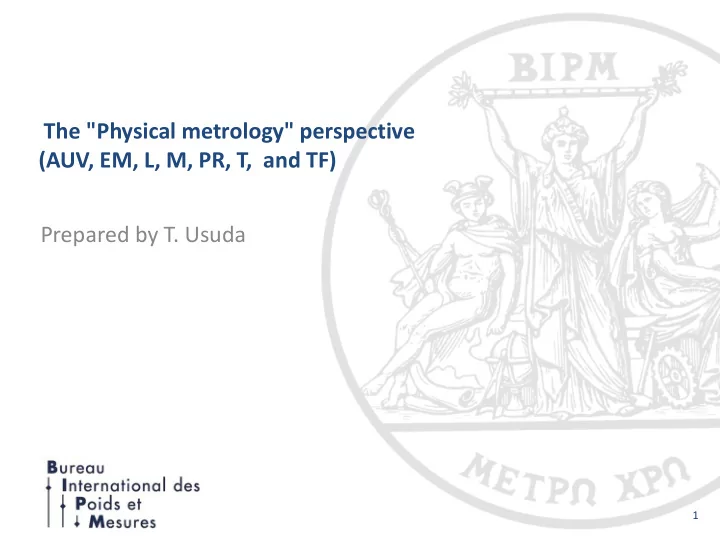

The "Physical metrology" perspective (AUV, EM, L, M, PR, T, and TF) Prepared by T. Usuda www.bipm.org www.bipm.org 1
Benefits and outcomes of the CIPM MRA Achieved mutual trust among NMIs existed prior to the MRA. – Main beneficiaries are NMIs and DIs. Provided a formal framework for the process of establishing degree of equivalence. This provides many technical protocols, standardized procedures, uncertainty estimations. – Beneficiaries are not only NMIs and DIs, but also accreditation bodies and industries as they can employ those protocols, procedures and estimations. Established transparent CMCs as a form of database and one-stop testing. – Main beneficiaries are regulatory authorities and accreditation bodies. – Direct benefits to industries of metrological services and devices. There must be “silent benefits” of metrology and traceability achieved by MRA, but not in particular about the MRA. www.bipm.org www.bipm.org 2
Feedback from stakeholders (1) AUV – Suppliers in automotive industry are requested to establish ISO 17025 or equivalent and be traceable to NMIs. EM – Fluke: “Before the MRA we had to re-calibrate more than 60 % of our calibrators imported in Europe. Today essentially 0 % recalibration is needed” PR – Formal commendation from two major manufacturers of LED chips, specifically mentioning piloting comparisons. T – Instrument vendors complain about competition due to traceability to “better” CMCs, although the smaller uncertainties are not relevant.” www.bipm.org www.bipm.org 3
Feedback from stakeholders (2) Not so many direct feedbacks. Intergovernmental organization e.g. CIE, IEA, IAU (International Astronomical Union), IGS (International GNSS Service), ITU-R (International Telecommunication Union-Radio communication Sector), and IUGG (International Union of Geodesy and Geophysics) would have a strong interest in CMCs To create awareness is important. There must be many stakeholders of beneficiaries of metrology and traceability achieved by MRA, but not in particular about the MRA. www.bipm.org www.bipm.org 4
Workload of comparisons Comparisons are the most important element of the MRA. Although there is an extensive workload in some cases, regular KCs are manageable in general. Scope of KCs and the reliability of CMCs are trade-off. Cycle of KCs and opportunity to participate are also trade-off. The pressure to avoid failure in a comparison is extending comparison time. The way to perform KCs should be changed like (almost) routine calibrations. Stable transfer should be developed in some areas (not in particular about the MRA) www.bipm.org www.bipm.org 5
Workload of review Some CCs introduced coordinated review to reduce or share the burden. Review process can be simplified though some NMIs or RMOs may not introduce the same simplification due to gaps of technical developments Even though review process may be simplified, should all NMIs and RMOs withhold the opportunity to review? Who could make an alert? Financing mechanism could be introduced (comparison and review)? www.bipm.org www.bipm.org 6
Workload of review (some combinations) Entire set review by four RMOs Selective review by each RMO Publication of CMCs Publication of CMCs Inter RMO review Inter RMO review RMO A RMO B RMO C RMO D Selected CMC set Entire CMC set Intra RMO review Intra RMO review CMC submission with CMC submission with supporting evidence supporting evidence Total workload of RMO level may be reduced but intensive workload be applied to a “coordinator” www.bipm.org www.bipm.org 7
Workload of review (some combinations) CCEM 2015 recommended to further reduce the volume of Inter-RMO reviews based on sampling • Prior to CCEM 2011: Up to 400% review (Four RMOs each reviewing the entire set) • Since CCEM 2011: 100% review (2-4 RMOs collectively reviewing the entire set) • After CCEM 2015: Selective review (<100 %, based on sampling) www.bipm.org www.bipm.org 8
Accessibility of DB Some CCs are simplifying service categories and CMCs. Expressions (matrix, numerical value, equation) are also under consideration. CCEM drastically reduced CMC entries by matrix without any lack of information. The current DB is provided “document base”, not real database. Better searchable and applicable database (e.g. Linked open data) is appreciated. Ideally, a web interface is added to the DB that arranges CMC submission and review. Funding needed to implement this. www.bipm.org www.bipm.org 9
Summary CCs are operating the MRA (KC, review) in manageable way. We have objective positive feedbacks from some specific stakeholders but not many. We should create awareness. Credibility and agility of publication of CMCs are trade-off with the workload of KCs (cycle) and review. Modernized database which allows to handle the data more semantically is appreciated. It should be noted that creation of mutual trust and a formal frame work for the process of establishing DoE are the great outcomes of the MRA. www.bipm.org www.bipm.org 10
Recommend
More recommend